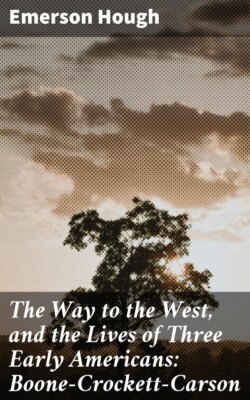The Way to the West, and the Lives of Three Early Americans: Boone—Crockett—Carson

Реклама. ООО «ЛитРес», ИНН: 7719571260.
Оглавление
Emerson Hough. The Way to the West, and the Lives of Three Early Americans: Boone—Crockett—Carson
The Way to the West, and the Lives of Three Early Americans: Boone—Crockett—Carson
Table of Contents
THE WAY TO THE WEST
CHAPTER I. THE AMERICAN AX
CHAPTER II. THE AMERICAN RIFLE
CHAPTER III. THE AMERICAN BOAT
CHAPTER IV. THE AMERICAN HORSE
CHAPTER V. THE PATHWAY OF THE WATERS[3]
CHAPTER VI. THE MISSISSIPPI, AND INDEPENDENCE[5]
CHAPTER VII. ORIGIN OF THE PIONEER
CHAPTER VIII. DANIEL BOONE
CHAPTER IX. A FRONTIER REPUBLIC
CHAPTER I. DAVY CROCKETT
CHAPTER II. AGAINST THE WATERS[16]
CHAPTER I. KIT CARSON
CHAPTER II. THE SANTA FÉ TRAIL
CHAPTER III. THE OREGON TRAIL
CHAPTER IV. EARLY EXPLORERS OF THE TRANS-MISSOURI
CHAPTER V. ACROSS THE WATERS[48]
CHAPTER I. THE IRON TRAILS
CHAPTER II. THE PATHWAYS OF THE FUTURE
Отрывок из книги
Emerson Hough
Published by Good Press, 2021
.....
“American settlement advanced toward the Mississippi in the shape of a wedge, of which the entering edge was first Lancaster, in Pennsylvania, then the Shenandoah valley, then Louisville, and finally St. Louis. When the second census of the United States was taken, in 1800, nearly all the white inhabitants of our country lived in a triangle formed by a diagonal southwestward from Portland, Maine, to the mouth of the Tennessee River, here meeting another diagonal running northwestward from Savannah, with the Atlantic for a base. Central and western New York, northern Pennsylvania, and all the territory north of the Ohio River, save in its immediate vicinity, were almost uninhabited by whites, and so were Georgia, Alabama, and Mississippi. Yet the state of Kentucky had half as many people as Massachusetts, and Tennessee had already been admitted into the Union.
“As a rule, geographical expansion proceeds along the lines of least resistance, following the natural highways afforded by navigable rivers and open plains. It is easily turned aside by mountain chains, dense forests, and hostile natives. Especially was this true in the days before railroads. But the development of our older West shows a striking exception to this rule; for the entering wedge was actually driven through one of the most rugged, difficult, and inhospitable regions to be found along the whole frontier of the British possessions.
.....